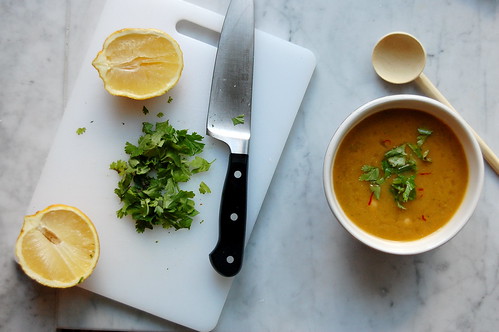
Hello from America, dear readers! I confess, I have been traveling like crazy these days, and while I want to write a long post about our Morocco adventures or give you all a great spring recipe with cardoons, I've been stuck on planes and trains and airports. (Speaking of travelogues, I want to do a site redesign over the summer when I have a bit of time off, and I want to start including some travel guides or write-ups with a Middle Eastern bent to them. Would that be of interest to you readers? Where to find good amlou in Morocco or fresh anchovies in Istanbul? Let me know in the comments.) In the meantime, today we're going to talk harira!
Harira is the traditional soup served in North Africa to break the fast during Ramadan. It is also just a stand-by soup, a delicious, reliable, and cheap option for dining in Morocco and Algeria. Traditionally, harira is a tomato-based soup, with a little bit of meat and some onions, legumes, and herbs. Harira is a soup that is very much about the broth, richly flavored from the bones used to make the soup.

I'd read on several Algerian cooking blogs (great resources for my culinary research, not to mention linguistic FrArabic oddities), about the harira from Oran. Oran (wahran, in the Arabic spelling), Algeria's second largest city, is on the coast close to Morocco. It was home to Camus and often pops up in American tales about WWII, as a base of the North African front.
Anyway, harira in the style of Oran is unique for its golden color, imparted by luxurious saffron. The sunny hue also comes from the vegetables used (usually carrots, sometimes pumpkin) as well as tomato paste. You see the Moroccan influence in the spices of the soup, warm with ginger, cumin, and paprika.
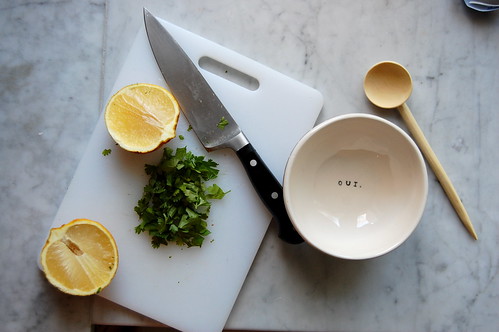
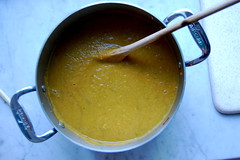
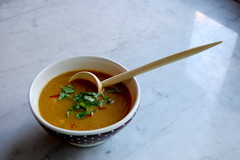
In researching the harira, I found several recipes that called for thickening the harira soup with levain (bread starter), a very old technique for thickening a soup. Other recipes called for thickening the soup with dchicha, a generic term for grits, like wheat, barley or freekah grits. Several versions called for a bit of lentils to thicken the soup, which I liked the best. The red lentils also preserve the color of the soup.
This soup is made the way most hariras are made, cooking the vegetable-broth mixture and pureeing it, then adding back in the chickpeas, herbs, and meat. This version is vegetarian (in all honesty, most harira has so little meat it's practically vegetarian anyway). The soup is brothy, cheerful in color, and you always brighten it at the end with some good doses of lemon juice.
About harira spoons: I got these harira spoons from the kindest old man in the souq in Marrakech. Harira spoons are carved by hand from a single piece of lemon tree wood. When the lemon tree branches become old and stop producing fruit, they are trimmed and used for spoons and small spice servers. They cost about 50 cents a piece in the souq.
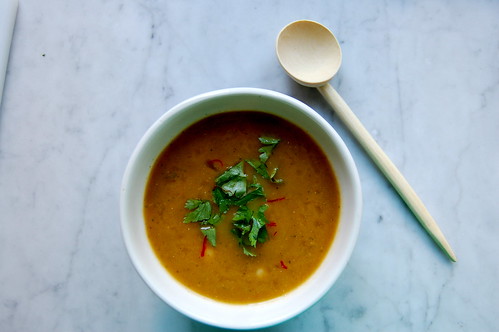
Harira in the Style of Oran (Harira Wahrani)
You can play around with different orange-colored vegetables here, try substituting squash for the carrots and turnips. I originally thought about including a yellow bell pepper (pictured above) but changed my mind at the last minute, though I imagine its sweetness would go nicely with the ginger.
1 small onion, chopped
2 cloves garlic, sliced
1/4 inch piece fresh ginger, peeled and diced
1 tablespoon tomato paste
4 medium-sized carrots, chopped
2 small turnips, peeled and chopped
3 tablespoons red lentils
1 teaspoon cumin
1/2 teaspoon sweet paprika
1/2 teaspoon ras al hanout spice mix (if available)
salt, black pepper
saffron, if available
1 bouquet of cilantro
a few pieces of parsley
6 cups rich chicken or beef broth, plus more for thinning the soup
2 cups cooked chickpeas
3 lemons
1. Heat some olive oil in a soup pot. Add the onion and cook, stirring occasionally, until soft, translucent, and starting to caramelize in places. Add in the garlic and ginger and let cook a few minutes, until fragrant. Add in the tomato paste and let toast for a minute. Stir in the lentils, carrots, and turnips and stir everything around the coat. Add in 1 teaspoon of salt, the cumin, paprika, ras al hanout, a few cracks of black pepper, and a few threads of saffron, crumbled. Stir everything around to coat and let cook a few minutes, until the spice are fragrant.
2. Add in the broth. The liquid should just cover the vegetables. If it doesn't, add water until you have enough liquid. Cover the pot and let simmer for 20 minutes.
3. Meanwhile, chop your bouquet of cilantro and the parsley. Set aside several pinches of cilantro to use as garnish. Juice two of the lemons. Chop the 3rd lemon into wedges and set aside to serve with the soup.
4. Puree the soup. If you don't have an immersion blender, don't forget to let the soup cool before blending. The soup should be brothy and not too thick (it's soup, not potage or puree). Adjust the thickness of the soup with any reserved broth or water.
5. Return the soup pot to the heat and add the cilantro/parsley, the chickpeas, and another large pinch of salt. Let the soup simmer for another 10-15 minutes. Add the lemon juice, stir to combine and taste for seasoning.
6. Ladle the soup into bowls and garnish with the cilantro and, if available, a few crushed saffron threads. Serve with the lemon wedges and good bread.

Ah Mercedes I've been reading your blog for a long time! I wish I would have known you were in Marrakech (my city now!) would have loved to invite you to the house for some "grandma cooked" Moroccan couscous or tajine! Look forward to reading more of your posts on Morocco
ReplyDeleteYes, please do a travel section. I love your writing style and would love to hear your experiences and tips!
ReplyDeleteI can't even begin to tell you how much I like your blog. Of all the fridges and pantries in the world I'd like to raid, yours (well, yours and Ottolenghi's) would be number one. Keep it up!
ReplyDeleteSadly, I can't imagine when I might be looking for 'amlou' in Morocco or anchovies in Istanbul, but if you are taking pictures and talking/writing about it, then I'll be logging on to read about it.
ReplyDelete(no relation)
Thanks so much for you kind comments! Amanda - we will certainly be back to Morocco, so maybe next time!
ReplyDeleteI do love your blog...but I can't tell from this recipe when to add the lentils! On an unrelated note, thank you so much for taking me to faraway lands, if only through dinner. - Liz
ReplyDeleteOops! You add them with the turnips and carrots, I'll fix it now!
ReplyDelete